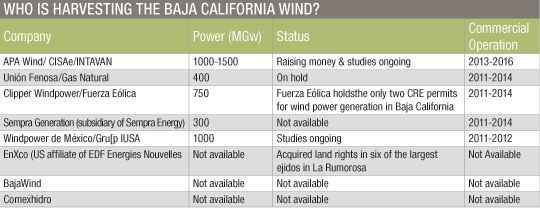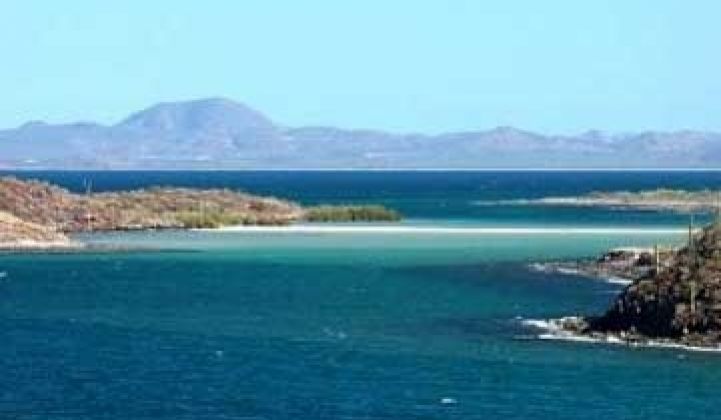Thanks to complex state regulations and lower costs, California could start getting its power from south of the border.
Half a dozen companies in Mexico want to provide wind-generated power to the state, according to developers and other sources. Asociados Panamericanos Wind (APA Wind), a Mexican-American wind-power developer company, for instance, is partnering with the Pai Pai indigenous community of Mission Santa Catarina in Baja California Norte, Mexico and neighboring landowners in an effort to build 1 to 1.5 gigawatts of wind-power projects on 263 square miles of land.
Once generated, the power will be delivered to the large, lucrative California renewable-energy market just 70 miles to the north.
APA Wind has secured internal funding to maintain options on the windy land in and around the indigenous Pai Pai Community of Mission Santa Catarina, and has come to terms on a joint venture with the Mexican firms CISAe/INTAVAN, according to Michael Folloni, Energy and Business Manager at APA. Ideally, the plant will be built in phases from 2013 to 2016.
"Solar developers are welcome to contact us. Solar projects can use APA's planned privately developed wind generator-tie lines," explained Folloni.
Although the lingering recession has blown away some companies in the Mexico-California effort, APA Wind is not alone. Sempra Energy, Cannon Power, Clipper United (Fuerza Eólica), BajaWind, and Windpower de México y Comexhidro are examining the cross-border possibilities, as well.
But developers going international face some other risks too, like losing any U.S. federal tax credits and having a whole new set of regulators to deal with.
Why so much interest?
According to data from the American Wind Energy Association (www.awea.org), wind remains one of the world's largest and fastest-growing sources of renewable power. Seven of the world's 10 largest markets for wind-powered electricity generation are in Europe, and America has to move fast to be part of the top five.
In the U.S., the Department of Energy (DOE) laid out a scenario for how wind could meet 20% of the nation's total electricity demand by 2030 -- about 300 gigawatts -- displacing half of natural gas-powered and 18% of coal-fired generation.
To accomplish this, however, new turbines and transmission lines will be needed. Many of the states with a large wind potential, such as the Dakotas, Montana and Wyoming, will need to ship generated power to dense population centers. NREL estimates the price tag for transmission capabilities could be as high as $93 billion.
Although California ranks 17th in the nation for wind, the state has high mandates for renewable energy. By 2020, California wants to get 33 percent of its power from renewable energy, so imports are welcome. But the state faces an even bigger problem: bureaucracy. Solar developers like BrightSource Energy have been squeezed because of regulations. Some developers already plan to build California power plants in Arizona to avoid dealing with the state's Fish and Game Department.
"There is a $100-billion market in California for 25,000 MW of power. In alternative sources, 40,000 MW is potentially available, 10,000 of that could come from wind and 30,000 from solar. There is more wind in Baja California than in all of the state of California," said the enthusiastic Folloni.

The potential beyond the border
Different studies estimate that wind energy in Baja California Norte ranges from 5 GW (according to California's Renewable Energy Transmission Initiative), to as much as 10 GW (according to the 2008 study "Challenges and Opportunities to Deliver Renewable Energy from Baja California Norte to California" by KEMA Inc. and Bates White for the California Energy Commission).
Another study, conducted by engineering, consulting and construction company Black & Veatch, locates Baja /La Rumorosa and southern territories as a wind resource rated at level 7 (the maximum, according to NREL's classification scale).
"Baja California (Norte), Mexico, presents an inviting opportunity, since it borders Southern California and has an abundant renewable resource potential," claims the KEMA study.
Providing energy is not a new issue between the borders. The United States and Mexico have traded electricity since 1905, when privately owned utilities in remote towns on both sides of the border helped meet one another's needs with a few interconnected low-voltage lines.
Today, Mexico has nine transmission interconnections with the United States. Five of these lines are high-voltage, DC connections that operate only in emergency situations. The Baja California electrical grid is isolated from Mexico's National Electric System (SEN) and is connected to the Western Electricity Coordinating Council (WECC) in the Unites States and Canada. The main flows of electricity between the U.S. and Mexico are between SEN in Baja California and the WECC, where there is a medium-voltage (230 kV) connection capacity of 800 MW.
However, there are some big hitches. "Developing a solar or wind project costs three times as much in California than in any other state in the U.S. So that is an advantage Baja California has. The disadvantages are that we do not get the Obama Administration's tax credits," said Folloni.
In Mexico, particularly in La Rumorosa, not all wind developers are connected directly to the California grid, so they may find it difficult to compete, given the costs of wheeling through the system of the Mexican public-power company, Comisión Federal de Electricidad (CFE). CFE typically computes a wheeling rate for each specific request that considers the distance the power is being wheeled and the embedded cost of the existing CFE transmission facilities.
CFE may also assess a capital charge for upgrades needed in its system to accommodate a wheeling request. These costs will reduce the competitiveness of Mexican renewable-energy projects that plan to wheel to the California ISO system through CFE. The CFE posts a table of sample point-to-point wheeling rates on its website annually, but actual wheeling rates for each specific wheeling request are determined by CFE on request. These costs could increase the overall cost of any renewable resources wheeled from Mexico to California.
One option to avoid such wheeling costs is to construct a dedicated transmission trunk line or generator tie line from the renewable resource in Mexico to the U.S. system. This is exactly the problem that APA is trying to solve.
Additionally, some wind developers currently face a supplier backlog. Unless a developer has an existing near-term delivery commitment in a turbine supplier's queue, it is unlikely that they could be on line 2010 or 2011.
Domestic politics play a role as well. Asked about how much of the energy generated by foreign wind farms would be used locally, David Muñoz Andrade, General Director at the State Energy Commission of Baja California Norte State, explained: "The region would use the quantity of energy that: 1) is economically viable and 2) is technically supportable, so these quantities should depend on market demand."
Congestion constraints
Wind-resource sites in the border region are remote from California ISO load centers and can experience delivery constraints due to California ISO transmission congestion. This can affect both the amount and the cost of energy delivered. The California ISO stated that congestion often occurs during peak conditions on San Diego Gas and Electric (SDG&E) transformer banks at Imperial Valley (from the 230 kV bus to the 500 kV bus) and at times during off-peak conditions on the Miguel 500/230 kV banks (from 500 kV to 230 kV).
Depending on the point of interconnection of Mexican wind renewables, it could either aggravate or help mitigate these congestion constraints. Transformer upgrades at either substation should be possible and would cost in the tens of millions of dollars. But such upgrades, combined with renewable additions, might cause congestion to occur at new points in the grid, which would have to be evaluated through detailed modeling of the transmission system.
Fortunately, the KEMA study points out, there is significant time-of-day diversity between wind- and solar-resource generation patterns in the border region during most of the year. Solar-energy output peaks during daylight hours and ramps to zero in the evening. On the other hand, wind generation along the border between SDG&E and Baja California typically peaks during the late evening, night and early-morning hours, except in winter, but less wind capacity is expected at that time of year, so the impact on congestion is reduced.
Eco-social impacts
Building wind farms in Mexico is easier than in California. But what about the ecological and social impact? Dr. Michael Wilken, professor of American Indian Studies at San Diego State University, said: "I am deeply concerned about the impacts that California's unquenchable thirst for energy is having on the cultural and natural resources of Baja California."
Professor Wilken also suggests a bi-national oversight team to monitor impacts and compliance throughout the process. The helpful academic even extended his own offer of help: "I would be glad to provide input in collaboration with RETI SSC members."
Wilken recalled: "The damage already done by Sempra LNG at one of the largest remaining areas of maritime coastal sage scrub of the Tijuana/Ensenada region, and the hurried excavations at the plant site, recovered only a minuscule fraction of the important archaeological site that existed there, representing a major loss for understanding the prehistory of our shared region."
In view of the impacts that the installation of wind-energy infrastructure will have on a significant part of the Juárez/Rumorosa Mountains, it will be critical to ensure that best practices in environmental and cultural resource management be applied.
To ensure best practices, Wilken has been following the APA Wind project. The Oakland-Ensenada company has made the Pai Pai indigenous community of Mission Santa Catarina in Baja California Norte, Mexico a half partner in developing wind on land the Pai Pai own. The APA-Pai Pai venture is called Apait, a word meaning "for everyone" in the Pai Pai tongue. "The APA-Pai Pai project it is an example of what should be done. Projects like this help to preserve the traditional way of life," Wilken said.
Some benefits were mentioned. David Muñoz, General Director at the State Energy Commission of Baja California Norte State, pointed out that the development of renewable-energy projects for export would "bring jobs, revenues for the ejidatarios (people from a community who shared communal land), better living conditions and less CO2 emission. For example, in some areas, far from small towns, they now have -- because of these kind of projects -- banks, ATMs, convenience stores, little hospitals and so on," he said.
Muñoz also pointed out that big projects either established new roads or paved old ones and added that, "more importantly, the incidence of fires in rural communities decreased because companies near these fields take care of their own property."
Political concerns
Politics are another element of discussion. Some have claimed that the green jobs should be generated on U.S. soil, but others prefer to get the green energy, no matter where it came from.
Is it about creating green jobs, creating clean energy or investing? "If it is clean and cheap, it doesn't matter," said Frank Thomas, Manager, Electric Project Development & Business Planning, San Diego Gas & Electric.
"It is a matter of grid parity," explained Don Watson, an independent consultant in renewable energies. APA Wind is making investments in Baja. Renewable energy from wind farms would help businesses in California to be more competitive with clean energy, and these are good things. It is about the business."
The big opportunity is that "the best easy wind sites are probably already taken in the U.S., but are probably not fully taken in northern Mexico," Watson added.



